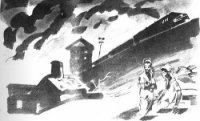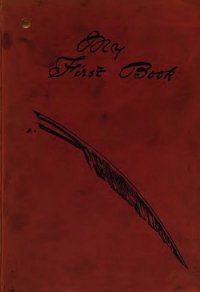Operation Nemesis: The Assassination Plot that Avenged the Armenian Genocide - Bogosian Eric (мир книг .txt) 📗
Alone, Tehlirian wandered into the garden running alongside the house. Dread welled up in his chest, the stench of blood filled his nostrils, and before he knew what was happening, he had collapsed onto the moist spring earth. He woke to the sound of cawing crows perched in the bare branches above as darkness gathered. Trembling uncontrollably, unsure of how he had ended up in his childhood garden, Tehlirian found his way out to the square. Disoriented, lost, and hollow with fear, he staggered toward the household of former neighbors.
A vision materialized before him. His older brother was standing in the yard. But this was not a hallucination; it was Misak in flesh and blood! The siblings fell into each other’s arms. Tehlirian’s brother had just arrived from Serbia and was also looking for the family. Aware that Soghomon was ill, Misak led him into the neighbor’s home.
After conversion to Islam, the neighbors had been allowed to remain behind in Erzincan unmolested. In the early days of the killings, this was policy. Conversion meant real salvation—literally, a means of saving one’s neck. “In order to sidestep the clutches of the CUP dictatorship, many Armenians saw themselves obliged to convert.”12 The focus was primarily on the children: “While the Ottoman authorities were intent on murdering all adult male Armenians, they occasionally presented women and children with the option of becoming Muslims.”13 At first there was also some leeway given to Catholic Armenians, clearly a political move on the part of the Sublime Porte. Over time, though, the option of conversion as a means to avoid a death sentence was retracted, and even those who had converted were ordered away.
With the publication of the best-seller My Grandmother in Turkey in 2004, more light was shed on the fate of the children who were converted and absorbed into Turkish society almost one hundred years earlier.14 My Grandmother is the story of Seher, the matriarch of author Fethiye Cetin’s extended Turkish family. In 1975 Seher summoned her twenty-five-year-old granddaughter to join her for a chat. Seher told her, “My name was Heranush.” This made no sense to Fethiye, as it was a Christian Armenian name. How could her Muslim grandmother have had a name like that? The old lady explained that when she was very small, she and her brother were adopted by separate Turkish families to save them from deportation. Her brother Horen worked in a nearby town as a shepherd. Heranush had been taken in as a household servant girl. Life was not easy, but the deportation caravan left without her, possibly sparing her life. Fethiye slowly came to realize what her grandmother was telling her: she, a Turk, had Armenian ancestry.
After the war, Heranush’s father, who was working in America at the time of the deportations, traveled to Aleppo. There he hired a smuggler who worked the Turkish-Syrian border. The plan was for the smuggler to find the children and slip them out of the country to Syria. The plan was only half-successful. Horen made it; Heranush didn’t. The little girl grew up Muslim, as a member of a Turkish family. As far as everyone was concerned, she was a Muslim Turk. Now, near the end of her life, she was letting her granddaughter in on the secret because before she died, she wanted to make contact with her brother. She believed he had been living in America all this time, and knowing that Fethiye had friends in academia, she concocted a plan to have her granddaughter find him. In fact, on a trip to Chicago, one of Fethiye’s fellow academics checked a phone book and discovered the family of Horen Bedrosyan, Heranush’s brother.
Sadly, Horen died soon after, and brother and sister were never reunited. Still, the connection had been made. Fethiye’s grandmother lived to be ninety-five years old, dying in 2000. She never met her extended American family. But Fethiye, the granddaughter, did make it back to Chicago and visited the Bedrosyans, who embraced her as the long-lost family member she was.
The publication of My Grandmother shook Turkish society. The memoir suggested that thousands of formerly Christian “grandmothers” had survived in Turkey, maybe tens of thousands. If this were true, what did this say about “Turkishness”? Pure-bloodedness? As the introduction to the book declares, “There are, by some estimates, as many as two million Turks who have at least one grandparent of Armenian extraction.”15
In a grotesque twist on the question of faith, foreign missionaries would sometimes give thanks to God for the steadfastness of their Armenian disciples even though they were being led to a certain death. Maria Jacobsen, a Danish missionary, writes in her journal for 1915 (July 10): “Now we have heard that anyone becoming a Mohammedan will be allowed to remain here in peace, and they come one after the other, to ask for our advice. Of course, we cannot advise anyone to let their faith down.” On October 24 she writes of one man who exclaimed, “They will try to make us Moslems, but I have taken my stand. I cannot do it. I would rather be killed.” Jacobsen follows with her blessing: “God help him to hold out to the end.” By 1917, as she watches the last remaining survivors starve to death before her eyes, Jacobsen writes, “Here there are still people who belong to the Lord and who have not soiled their garments with sin.”16
Tehlirian sat quietly in the dining room of the neighbors’ half-ruined house as survivors told stories from their travels and a feast of sweet choereg bread, eggs, cheese, and pickles was laid out. Gossip was shared. Misak and Soghomon were hailed as brave soldiers. But Soghomon found himself unable to smile. Of the 25,000 Armenians who had been living peacefully in Erzincan, little could be said. The truth was too horrible to face.
Five years later, when Soghomon Tehlirian took the stand at his trial, he knew that the people of his hometown had been rounded up and killed, but he still didn’t know the details of the killings. Historians have since pieced together how the Armenians of Erzincan were disposed of. 17
As usual, the first act of the deportation was to round up the politically oriented notables. After their arrest, these men were tortured and summarily executed. Then, on Sunday May 16, 1915, the local priest of Erzincan, Father Mesrob, was ordered by the local Turkish authorities to alert his people to a deportation. On May 18, the sixteen most affluent families of the town were deported to Konya, a dry, inhospitable town, deeply Islamic, some five hundred miles from Erzincan. (It is doubtful that the families actually ever made it there.) On May 23, a force of twelve thousand gendarmes (Turkish police), Special Organization chetes, and Muslim peasants arrived and began the process of herding Armenians from the town and the neighboring villages. Able-bodied men were separated and “either shot or had their throats cut in trenches which had been dug in advance.” Women and children were sent to the Erzincan Armenian cemetery to be concentrated in preparation for transfer to the killing areas. On May 28, deportees were dispatched from town in groups at one-hour intervals. They followed a road that ran along the top of the Kemah Gorge (actually a series of gorges) approximately three hours from the city. Here the cliffs along the Euphrates River are hundreds of feet high. According to the French historian Raymond Kevorkian, “the Armenians were caught in a trap from which there was no escape: on the one side was the turbulent Euphrates and, on the other, the cliffs of the Mt. Sebuh mountain chain.” The victims were stripped of their belongings by squadrons of the Teskilat-I Mahsusa (Special Organization). “Veritable slaughterhouses had been set up, in which some 25,000 people were exterminated in one day. Hundreds of young women and children joined hands and leaped into the void together.”




